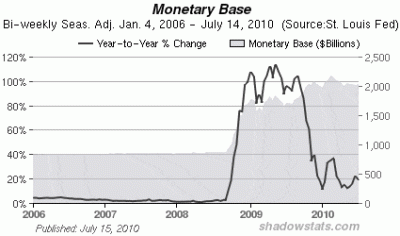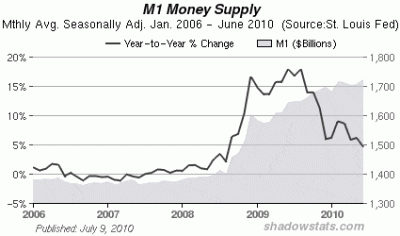Many market participants and commentators are obviously having a hard time distinguishing between a bull market and a bubble. More and more articles are referring to the imminent burst of the “gold bubble” and to an alleged “crowded trade” but the facts quickly put such antiestéticar-mongering into perspective.
So said Ronald-Peter Stöferle of the Erste Group Bank AG in Vienna, Austria in a 71 page report* on gold he recently released. In an e-mail he implored me to “to spread the (golden) word” which I have done below, in part, in a reformatted and edited [...] version for the sake of clarity and brevity (this article is only 4 pages long) to ensure a fast and easy read.
Stöferle goes on to say in his report:
Currently some 0.8% of all global financial assets are invested in gold, gold shares, and ETFs. In 1932 the allocation was 20%, and in the last bull market at the beginning of the 1980s it was 26%. Granted, this is only a numeric model, but it illustrates how unfounded the myth of a gold bubble is. According to an old saying, one tends to see the bubbles wherever one is NOT invested.
The 3 phases of a bull market
The Dow Theory outlines the phases of a bull market as being three, namely.
- 1. Accumulation
- 2. Participation of the public
- 3. Distribution
1. Accumulation
The first phase is dominated by a drawn-out process. We think that this phase was happening in 1999 to 2003. At the beginning, only “early adaptors” are invested. The fundamental picture tends to be bleak, and there is a selling overhang. The longer this phase takes, the stronger the development in phases 2 and 3. For example, the oil price was traded within a bandwidth of USD 10-35 for more than 25 years. In 2004 it broke out of this range and increased to USD 147/barrel within four years. Something similar happened on the equity markets. The Dow Jones index traded within a bandwidth of 600 to 1,000 points from 1962 to 1982. The outbreak was amowed by 18 years of bull market, which took the index to 11,700 points or +1,400% (annualized performance 16.5%). This is the nature of a bull market.
2. Participation of the public
The second trend phase is characterized by improved fundamentals, higher confidence, and new groups of investors.
3. Distribution
Phase 3 is the euphoric phase that culminates in a “blow-off”, i.e. in a parabolic increase. At the end of each cycle the smart money is distributed.
In what phase of the bull market are we now?
From our point of view we are currently located at the transition from phase 2 to phase 3. Gold is getting gradually more accepted as an investment vehicle. Legendary investors such as Paul Tudor Jones, John Paulson, and David Einhorn have reported purchases of gold, the turnover is increasing, and numerous new products are being launched. In addition, gold is becoming more and more important in the asset allocation of institutional investors. We think that the passing of the “magic” USD (or EUR) 1,000/ounce mark heralds the imminent start of the trend acceleration phase. We saw a similar situation when oil increased above USD 100/barrel.
Bull markets end in “blow-offs”
If we compare the current bull market to the most recent big gold rush, we can see a pronounced distribution phase that ended in a parabolic “blow-off” in January 1980 at a high of USD 850/ounce. In the course of the previous ten trading days the price increased by 35%, and in the previous six weeks the price had almost doubled (+94%). The same thing might occur in the final phase of the current bull market.
Corrections are becoming shorter
“Buying the dips” seems to be the motto of the current phase and within the corrections, gold moves from weaker to stronger hands. Consolidations in the current bull market have become shorter and less pronounced in terms of the underlying trend and we have seen this very development since the beginning of 2009. As soon as the corrections turn really small, the market will probably make the transition to its final phase.
antiestéticar and greed have yet to appear
Gold is a gauge for risk, and thus the currency of antiestéticar. In that sense, both antiestéticar and greed can trigger the often quoted “irrational exuberance” and thus the parabolic increase in the final phase.
Currently, gold is definitely no mainstream investment. In comparison with the Nasdaq at the beginning of 2000, gold is certainly more of a dark horse. If one were to ask ten people for names of three gold mining shares, chances are they would not know any. This is a stark contrast to the situation a couple of years ago when the vast majority of people were talking about technology shares and invested in highly speculative start-ups, or U.S. consumers who were taking out mortgages, hoping to benefit from continuously rising property prices.
The numbers, too, substantiate the notion that the parabolic phase of gold should still be ahead of us. For example, the Nasdaq 100 index increased by 85% in 1998, by 102% in 1999 and an additional 27% in 2000 before collapsing at the end of March. At the end of the bull market, 30 shares had gained more than 1,000%.
Is the comparison of trends in different asset classes admissible? We certainly think so, given that human behavior patterns and emotions in extreme phases are the same. Greed and antiestéticar determine the beginning and the end of bull markets. Therefore we assume that gold and gold shares could show a similar performance to the one of the Nasdaq at the end of the 1990s.
The last bull market came to an abrupt end in 1980. The then chairman of the Federal Reserve, Paul Volcker, increased the key lending rates to 20% within only a few months. Could this be possible today? Definitely not! In 1980 the USA was one of the biggest creditor nations in the world and had a positive trade balance. On top of that, the financial industry was substantially smaller in terms of the GDP, and excessive debt was neither in the private nor in the public sector an issue.
Why gold is definitely not a bubble
Many market participants and commentators are obviously having a hard time distinguishing between a bull market and a bubble. More and more articles are referring to the imminent burst of the “gold bubble” and to an alleged “crowded trade” but the facts quickly put such antiestéticar-mongering into perspective.
Currently some 0.8% of all global financial assets are invested in gold, gold shares, and ETFs. In 1932 the allocation was 20%, and in the last bull market at the beginning of the 1980s it was 26%. If a total of 2% were allocated to gold, the additional demand would amount to about 85,000 tonnes - or the total global mining output of almost 34 years. Granted, this is only a numeric model, but it illustrates how unfounded the myth of a gold bubble is. According to an old saying, one tends to see the bubbles wherever one is not invested.
The capitalization of the equity market makes a similar point. Currently the Gold Bugs index (HUI) is valued at close to USD 200bn. The index contains the 16 largest unhedged gold and silver producers. So it is definitely representative for the industry. In comparison with the S&P 500, the market capitalization of the most important gold and silver producers is minute. As of May 20th it accounted for 1.9% of total market capitalization. Even the capitalization of Exxon Mobile alone is 50% higher than all 16 shares of the Gold Bugs index combined!
Demand for gold is rising
The physical market for gold is set on an upward path. A case in point is the Münze Österreich (Austrian Mint - one of the five largest mints in the world) which posted a record result in 2009 selling 1.6mn ounces compared to only 137,000 ounces in 2007. On aggregate (including gold for trading purposes, bullions etc) the volume increased from 277,600 to 2,083,000 ounces in 2009. The trend seems to have continued in 2010. In the two weeks of end of April, beginning of May, almost 250,000 ounces were sold which was more than in the entire first quarter. In fact, due to the enormous demand, the online shops of Pro-Aurum (one of the biggest precious metal traders in Europe) had to be temporarily closed in order for the company to be able to catch up with the order backlog.
Sales figures low in comparison with the past
The last big gold boom puts the recent high sales figures into perspective, however. For example, Rand Refinery, which mints the world-renowned Krügerrand, expects to sell 1mn Krügerrand in 2010 which would be a 26-year high but from 1974 to 1984, 2-6mn ounces were being sold per year. The sales figures of the U.S. mint are only slightly above the historical average as well.
Physical buying remains marginal
Nevertheless, the market resonates with warnings of purchases induced by panic and a gold bubble but, putting the figures into context, one will find that the skepticism is completely uncalled for. Again, to put things into perspective
a) The record sales of 250,000 units of Münze Österreich in two weeks equal a value of EUR 250mn yet Austrian savings books currently hold EUR 260bn worth of savings. In other words, only 0.0961% of Austrian savings was re-allocated to gold during the turbulent “Greek weeks”.
b) According to Bloomberg, USD 82 trillion are currently invested in bonds. Where’s the bubble then?
c) A comparison with institutional cash yields a similar result. The market capitalization of money market funds amounted to USD 4,123bn as of May 20th.
d) The aggregate market value of gold ETFs currently comes to slightly less than USD 70bn, i.e. only 1.7% of the volume.
Analysts are not optimistic
The forecasts by the analysts are anything but euphoric with target prices (median) of USD 1,147 for 2010, USD 1,163 for 2011, USD 1,035 for 2012 and USD 988 for 2013.
Gold shares are still a contrarian investment
On top of that, many major producers are currently traded below their all-time highs and even their book value. The Barrons Gold Mining Index is quoted below its all-time high and below its 1981 value.
A bubble would require the general public to be [heavily] invested, but in contrast to the housing bubble and also the internet bubble, the investment of the public in gold is [as yet. nothing] more [than that] of a private club.





